St Fagans National History Museum
| Sain Ffagan: Amgueddfa Werin Cymru | |
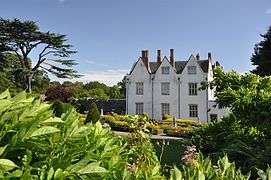 St Fagans Castle in its grounds | |
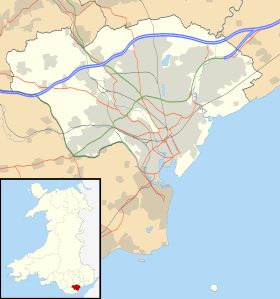 Location in Cardiff, Wales | |
| Established | 1948 |
|---|---|
| Location | St Fagans, Cardiff, Wales |
| Coordinates | 51°29′13″N 3°16′21″W / 51.4869°N 3.2725°WCoordinates: 51°29′13″N 3°16′21″W / 51.4869°N 3.2725°W |
| Visitors |
610,155 (2010)[1] |
| Website | www.museumwales.ac.uk/en/stfagans/ |
St Fagans National History Museum (Welsh: Sain Ffagan: Amgueddfa Werin Cymru), commonly referred to as St Fagans after the village where it is located, is an open-air museum in Cardiff chronicling the historical lifestyle, culture, and architecture of the Welsh people. The museum is part of the wider network of Amgueddfa Cymru – National Museum Wales.
It consists of more than forty re-erected buildings from various locations in Wales, and is set in the grounds of St Fagans Castle, an Elizabethan manor house. In 2011 Which? magazine named the museum the United Kingdom's favourite visitor attraction.[2]
History
The museum was started in 1946 following the donation of the castle and lands by the Earl of Plymouth. It opened its doors to the public in 1948, under the name of the Welsh Folk Museum. The museum's name in Welsh (also meaning "Welsh Folk Museum") has remained unchanged since that date, whereas the English title was modified once to Museum of Welsh Life, and again to its current nomenclature.
The brainchild of Iorwerth Peate, the museum was modelled on Skansen, the outdoor museum of vernacular Swedish architecture in Stockholm. Most structures re-erected in Skansen were built of wood and are thus easily taken apart and reassembled, but a comparable museum in Wales was going to be more ambitious, as much of the vernacular architecture of Wales is made of masonry.
Buildings and exhibits

The museum includes more than forty buildings which represent the architecture of Wales, including a nonconformist chapel (in this case, Unitarian), a village schoolhouse, a Toll road tollbooth (below), a cockpit (below), a pigsty (below), and a tannery (below).
The museum holds displays of traditional crafts with a working blacksmith forge, a pottery, a weaver, miller, and clog maker. It also includes two working water mills: one flour mill and one wool mill. Part of the site includes a small working farm which concentrates on preserving local Welsh native breeds of livestock. Produce from the museum's bakery and flour mill is available for sale.
The medieval parish church of Saint Teilo, formerly at Llandeilo Tal-y-bont in west Glamorgan (restored to its pre-Reformation state), was opened in October 2007 by the Archbishop of Canterbury, Rowan Williams. A Tudor merchant's house from Haverfordwest, opened in 2012, is the latest building to be added to the museum's collection.[3] Future plans include the relocation of the historic Vulcan public house from Newtown in Cardiff.[4]
Although the museum was intended to preserve aspects of Welsh rural life, it now includes several buildings that depict the industrial working life that succeeded it, that being almost extinct in Wales. There is a row of workers' cottages, depicting furnishing from 1800–1985, from Rhyd-y-car near Merthyr Tydfil (below), as well as the pristine Oakdale Workmen's Institute (below). Even a post-war prefabricated bungalow (below) has been erected on the grounds.
Since 1996 the museum has hosted the Everyman Summer Theatre Festival when it re-located from Dyffryn Gardens. This festival, which includes a Shakespeare play, a Musical, and a Children's Show has become part of Welsh theatrical calendar since its founding at Dyffryn in 1983.
Scenes from the Doctor Who episodes "Human Nature" and "The Family of Blood" were filmed at the museum.
It is planned that The Vulcan Hotel that was originally located in Adam Street, Cardiff, will be rebuilt on the site. It had originally opened in 1853, but closed for the last time in May 2012, but was dismantled in 2013 and is now in storage. It is hoped to restore the pub as it would have looked in 1915.[5]
List of structures
| Image | Name | Date | Re-erected | Original site | County (historic) |
Unitary Authority (modern) |
Listing |
|---|---|---|---|---|---|---|---|
 |
(Percy Thomas Partnership architects). |
1968–74 | — | St Fagans | Glamorgan | Cardiff | |
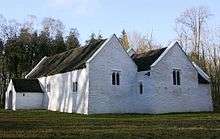 |
St Teilo's Church | c. 1100–c. 1520
(present form: c. 1520) |
2007 | Llandeilo Tal-y-bont, near Pontarddulais | Glamorgan | Swansea | — |
 |
Cilewent farmhouse | begun 1470
(present form: 1734) |
1959 | Cwmdauddwr | Radnorshire | Powys | Grade II |
 |
Tudor Trader House | 16th century | 2012 | Haverfordwest | Pembrokeshire | Pembrokeshire | — |
 |
Hendre'r Ywydd Uchaf farmhouse | 1508 | 1962 | Llangynhafal, near Llandyrnog | Denbighshire | Denbighshire | Grade II |
 |
Y Garreg Fawr farmhouse | 1544 | 1984 | Waunfawr | Caernarfonshire | Gwynedd | |
 |
Stryd Lydan barn | c. 1550 | 1951 | Penley | Flintshire | Wrexham | Grade II |
 |
St Fagans Castle | 1580 | — | St Fagans | Glamorgan | Cardiff | Grade I |
| Dovecote | 18th century | — | St Fagans | Glamorgan | Cardiff | Grade II | |
 |
Hendre Wen barn | c. 1600 | 1982 | Llanrwst | Denbighshire | Conwy | — |
 |
Hawk and Buckle Inn cockpit | 17th century | 1970 | Denbigh | Denbighshire | Denbighshire | Grade II |
| Kennixton Farmhouse | 1610 | 1955 | Llangennith | Glamorgan | Swansea | Grade II | |
| Lead cistern in east forecourt of St Fagans Castle |
1620 | — | St Fagans | Glamorgan | Cardiff | Grade II* | |
 |
Abernodwydd farmhouse | 1678 | 1955 | Llangadfan | Montgomeryshire | Powys | Grade II |
 |
Smithy | 18th century | 1972 | Llawryglyn | Montgomeryshire | Powys | Grade II |
 |
Tannery | late 18th century | 1968 | Rhayader | Montgomeryshire | Powys | Grade II |
 |
Esgair Moel woollen mill | 1760 | 1952 | Llanwrtyd | Brecknockshire | Powys | Grade II |
 |
Llainfadyn cottage | 1762 | 1962 | Rhostryfan | Caernarfonshire | Gwynedd | Grade II |
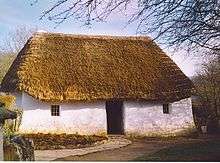 |
Nant Wallter cottage | c. 1770 | 1993 | Taliaris, near Llandeilo | Carmarthenshire | Carmarthenshire | — |
 |
Southgate tollhouse | 1772 | 1968 | Penparcau, Aberystwyth | Cardiganshire | Ceredigion | Grade II |
 |
Pen Rhiw Unitarian chapel | 1777 | 1956 | Dre-fach Felindre | Carmarthenshire | Carmarthenshire | Grade II |
 |
Cae Adda byre | 18th–19th century | 2003 | Waunfawr | Caernarfonshire | Gwynedd | — |
 |
Pigsty | c. 1800 | 1977 | Hendre Ifan Prosser | Glamorgan | Rhondda Cynon Taf | — |
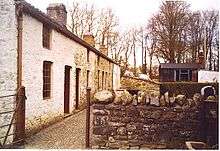 |
Rhyd-y-Car ironworkers' cottages | c. 1800 | 1986 | Rhyd-y-Car, Merthyr Tydfil | Glamorgan | Merthyr Tydfil | — |
 |
Llwyn-yr-Eos farmhouse | begun 1820 | — | St Fagans | Glamorgan | Cardiff | Grade II |
 |
Gorse mill | after 1842 | 1983 | Dôl-wen | Denbighshire | Denbighshire | — |
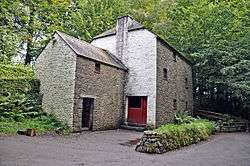 |
Melin Bompren corn mill | begun 1852 | 1977 | Cross Inn | Ceredigion | — | |
 |
Hayshed | 1870 | 1977 | Maentwrog | Gwynedd | — | |
 |
Summer House | c. 1880 | 1988 | Bute Park, Cardiff | Glamorgan | Cardiff | — |
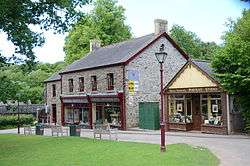 |
Gwalia Stores | 1880 | 1991 | Ogmore Vale | Glamorgan | Bridgend | — |
 |
Maestir School | in use 1880–1916 | 1984 | Maestir, near Lampeter | Cardiganshire | Ceredigion | — |
 |
Sawmill | 1892 | 1994 | Tŷ'n Rhos, near Llanddewi Brefi | Ceredigion | — | |
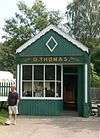 |
Tailor's shop | 1896 (extended 1920s) | 1992 | Cross Inn | Ceredigion | — | |
| Ewenny Pottery | c. 1900 | 1988 | Ewenny | Glamorgan | Vale of Glamorgan | — | |
 |
Derwen bakehouse | 1900 | 1987 | Thespian Street, Aberystwyth | Cardiganshire | Ceredigion | — |
 |
Urinal | c. 1901–10 | Llandrindod railway station | Radnorshire | Powys | — | |
| Oakdale Workmen's Institute | 1916 | 1995 | Oakdale | Monmouthshire | Caerphilly | — | |
| Saddler's workshop | 1926 | 1986 | St Clears | Carmarthenshire | Carmarthenshire | — | |
 |
Blaenwaun Post Office | 1936 | 1992 | Blaenwaun, near Whitland | Carmarthenshire | Carmarthenshire | — |
| Newbridge War Memorial | 1936 | 1996 | Caetwmpyn Park, Newbridge | Monmouthshire | Caerphilly | — | |
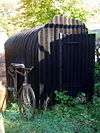 |
Anderson air raid shelter | c. 1939–45 | — | ||||
 |
Prefab bungalow | 1948 | 1998 | Gabalfa, Cardiff | Glamorgan | Cardiff | — |
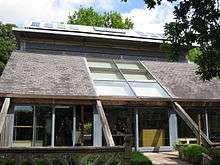 |
House of the Future/ Ty Gwyrdd | 2000 [6] | — | St Fagans | Glamorgan | Cardiff | |
 |
Iron Age roundhouses | 2015 [7] (Reconstruction) |
— | ||||
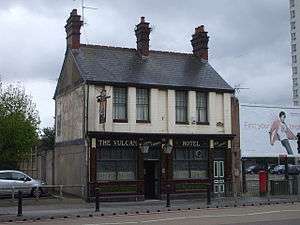 |
The Vulcan Hotel | 1853 | in progress | Adamsdown, Cardiff | Glamorgan | Cardiff | — |
Minor exhibits
-
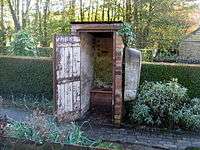
Tŷ-Bach (Little House). Toilet in the garden of Rhyd-y-Car ironworkers' cottages
-
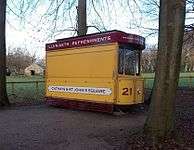
A Cardiff refreshment kiosk
Future developments
- Scheduled to open by 2016 is a £24m revamp of the main museum building, together with the construction of two new gallery or exhibition buildings[8]
- Based on archaeological findings, the construction of an Iron Age farmstead from Anglesey, and Llys Rhosyr, a thirteenth-century court of the princes of Gwynedd[8]
- The rebuilding of the Victorian police station from Taff's Well, Rhondda Cynon Taf.[9]
- In 2012 it was announced that Raglan railway station would be rebuilt at the museum.[10]
References
- ↑ "Visits made in 2010 to visitor attractions in membership with ALVA". Association of Leading Visitor Attractions. Retrieved 22 October 2011.
- ↑ Clare Hutchinson (29 September 2011). "National History Museum at St Fagans soars to the top of UK's favourite tourist sites". WalesOnline. Retrieved 22 October 2011.
- ↑ BBC News, "Haverfordwest Tudor trader home opens at St Fagans museum", 2 July 2012. Accessed 11 September 2013
- ↑ BBC News – ""Work starts to move Cardiff's Vulcan pub to St Fagans museum", 12 July 2012. Accessed 30 September 2013
- ↑ BBC News, "Plans to rebuild Cardiff's Vulcan pub at St Fagans submitted", 28 July 2013. Accessed 02 February 2014
- ↑ "First tenants meet house of the future". BBC Wales. 30 September 2000. Retrieved 9 March 2016.
- ↑ Bryn Eryr: from house to home, Amgueddfa Blog (National Museum Wales), 18 August 2015. Retrieved 31 October 2015.
- 1 2 "Cardiff". walesonline.
- ↑ "St Fagans: National History Museum police station plans". BBC News. 21 July 2011. Retrieved 6 May 2012.
- ↑ Prior, Neil (28 November 2012), Raglan railway station to move to St Fagans museum, BBC News, retrieved 3 August 2015
External links
| Wikimedia Commons has media related to St Fagans National History Museum. |
- Official website
- The buildings of St Fagans
- BBC Wales site including panoramic views of buildings in the museum
- Everyman Theatre
- St Fagans National History Museum at Gathering the Jewels
- Celebration of St Dwynwen's day in Wales
